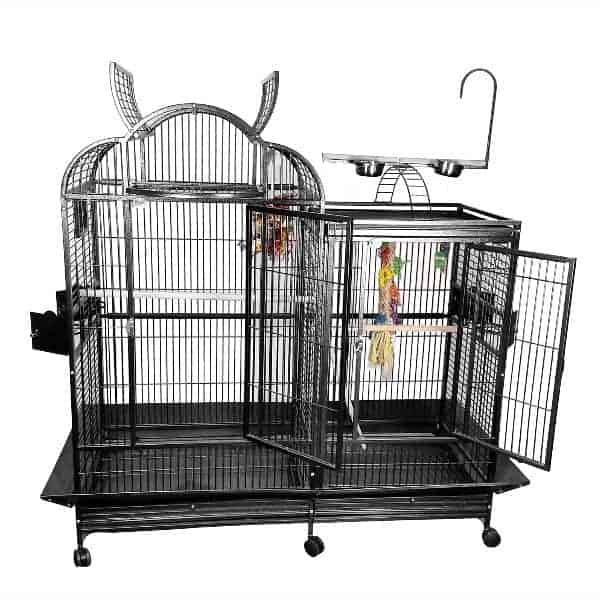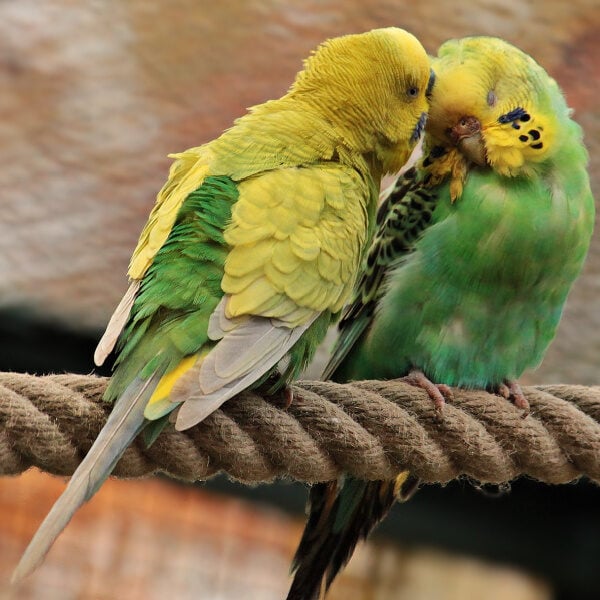Last Updated on by Mitch Rezman
I thought it was appropriate while introducing some of our newest divided cages to talk about the best uses for a divided birdcage. As luck would have it the following question came across my digital desk.
from: Kristen
I have an Umbrella cockatoo and a Conure and we’d like to combine their enclosures. Is the left side of this divided cage AE PC-4226D (above) large enough for an umbrella cockatoo? Thanks for the info.
Hi Kristen,
what is your motivation for placing the birds in the same cage? My concern is the Cockatoo biting the toe off the conure when no one’s around and the conure is left to bleed out. Unless they’ve been housed together for a while it’s generally not recommended to share the same enclosure.
In direct answer to your question, the size of the cage is directly related to the human’s lifestyle – if the bird is going to be in the cage for 6 – 8 hours a day, it’s much too small for a U2 – if it’s only used for sleeping it would be fine
MitchR
Hi Mitch,
Thank you for your note.
Our birds are in cages next to each other at present. Our cockatoo’s cage is large but needs replacing, and I was just pondering the thought of combining the cages (but not housing the birds together without a dividing barrier).
They are both entertained by being near each other, but I would obviously never let them alone together. With this kind of cage, can they actually reach the other through the divider? (I noticed you have a larger divided parrot cage – HQ 36432, which I’m assuming would probably be the right size for the cockatoo, but if it is possible to grab/bite the conure through the divider, that wouldn’t work – can you advise about this? )
Both birds are out of the cage a lot – I work from home and have three homeschooling kids, so they get a lot of attention.
Thanks for the information, and best wishes,
Kristen
Kristen
That said, cage size is a nonissue. The problem is twofold – all divided cages use dividers just like cage walls, The foot biting often occurs at night and is reactionary due to darkness. You can introduce a plastic barrier as well but that’s miserable to clean.
The other possible issue is an Umbrella Cockatoo and a Conure (you don”t say what kind and sizes varies greatly with Conures) have fairly different needs in terms of toys, perches and accessories – this is something you may have worked out but it is a consideration.
We feel caged bird keeping best practices should be to use a cage like this for a pair of small to medium-sized birds like
Senegals, small Conures or Caiques whether they are breeding or not. Much like human couples, separation is not always a bad thing.
Every circumstance is different. I’ve been witness to cage mate combinations I never dreamed would work (Triton Cockatoo – Umbrella Cockatoo (U12) and a Congo African Grey – for 7 years) BUT more often than not, 2 birds in a cage will cause stress to one or both birds regardless of sexual combinations. Stress is another trigger which can manifest itself in physical illness, Nuff said.
I can’t decide if having access to Google 24/7 is making us smarter or dumber? The last century when I was growing up I learned like many of us that salted peanuts tasted great but it wasn’t until I was well into my teens that I found out that they got the salt on the peanut that was inside the shell, by soaking the entire peanut shell in a salty brine solution that passed through the shell and magically gave the hidden parts, the delicious salty flavor.
How does this relate to anything about birds especially that you should not give birds salted anything? What got me thinking about this was reviewing some listings in the Lafeber’s category. I think Lafeber’s is an under-understood and under-appreciated source of bird nutrition.
We carry a lot of bird seed blends. Sometimes I like to focus the individual manufacturer taking the time to point out facts about their products that are not always fully understood. Like Avi-Cakes that are 50% pellets. Hulled grains, seeds, and fruit in the case of Fruit Delight Avi-Cakes, are blended with pellets.
Have you thought about or failed in converting your bird to pellets? When was the last time your bird got excited about a bowl full of pellets? Pellets offer complete nutrition but not much in the way of taste or texture. Have you ever considered Classic Nutri-Berries for Parrots? They are nutritionally balanced like pellets, just not ground up. Both pellets and Nutri-Berries contain seeds and grains. When manufacturing pellets, they are finely ground into powder before being formed into a pellet. Most of the seeds and grains in Nutri-Berries are kept whole because Dr. Lafeber discovered how to nutritionally balance them like pellets without grinding.
Let’s focus on the words “Hulled grains, seed” which make Lafeber’s uniquely more nutritious, and here’s why. I’ll quote from their website “The secret is hulling. By hulling the seeds and grains and then coating them with stabilized vitamins, chelated minerals and amino acids, your bird receives premium nutrition. Plus unground seeds and grains provide the benefit of whole foods like parrots have in the wild.”
All those hulls under your bird’s cage (that do nothing but add to the joy of caged bird keeping 🙂 are covered with all the “fortified vitamins” found in many seed formulations. Those are all the vitamins and minerals your bird is not getting because they spend most of their time eating, removing the hulls. Which is why we always recommend a supplemental multivitamin for any caged bird on an all seed diet – get it?
What other benefits does your bird get when eating Lafeber’s products? To quote their website “Fun foraging with whole seeds and grains. Meals should be exciting, not boring. With Nutri-Berries your bird enjoys the crunching of seeds and grains, biting into whole seeds and playing with the round shape. All this is a vital part healthy foraging”.
To make the decision easy for you to try Avi-Cakes or Nutriberries for the first time or to stock up because you know they will never last long enough to go out of date, we’ve lowered all the prices!
It’s spring and it is the time you drag the birdcage out to the backyard, fire up the pressure washer to remove last winter’s worth of poop, food particulate, powder coating – wait. You thought you were doing the right thing. Cut it out!
If you’re reading this on a mobile device like a tablet or smart phone, I’d like you to walk over in stand in front of your birdcage. Look at the four corners of your birdcage. Also look at the horizontal cross members that the vertical bars are going through (or welded to). Notice they are much wider than the “bars” of your birdcage. Depending upon the age of your cage the vertical “bars” may pass through many drilled holes in the horizontal structural components or may terminate with welds on the top and the bottom of said horizontal pieces. The bars of your birdcage are solid metal. The cage “corners” and “horizontal members” are hollow
You may or may not have noticed while assembling your cage, very small holes on these wider structural components of your birdcage. The small holes are used to hang components of the birdcage while in the powder coating portion of birdcage manufacturing. The small holes double as “weep” holes allowing water to escape from the interior of these HOLLOW components of your birdcage.
Huh? The corners and horizontal structural components of your bird cage are HOLLOW meaning when you use the pressure washer – garden hose – shower head, to clean your birdcage, you are soaking these hollow portions which have no powder coating on the interior of them thus accelerating the rate of oxidization better known as RUST.
Powder coating “bonds” with metal. Rust easily breaks this bond. To ensure the maximum life of your birdcage, we suggest you get a steamer. It allows you to clean your cage without moving your cage. You can easily clean and sanitize not only the cage but all the bird toys and accessories, all in the time it takes to brew a pot of coffee.
You’re welcome.
Comments are encouraged below.
Written by Mitch Rezman
Approved by Catherine Tobsing
Author Profile
Latest entries
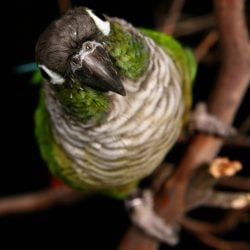 Bird & Parrot CareJune 6, 2025Green Cheek Conure: The Ultimate Guide for Parrot Lovers
Bird & Parrot CareJune 6, 2025Green Cheek Conure: The Ultimate Guide for Parrot Lovers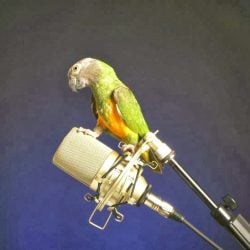 Bird & Parrot AnatomyJune 5, 2025How Can Parrots Be Recognized by Their Voices?
Bird & Parrot AnatomyJune 5, 2025How Can Parrots Be Recognized by Their Voices?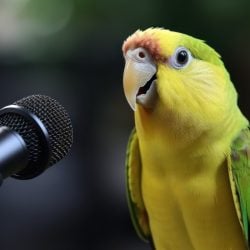 African greyMay 28, 2025Teaching a Parrot to Talk: A Dice Shot of Nature and Nurture
African greyMay 28, 2025Teaching a Parrot to Talk: A Dice Shot of Nature and Nurture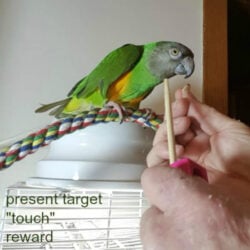 Bird BehaviorMay 28, 2025Parrot Target Training ~ A Comprehensive Guide
Bird BehaviorMay 28, 2025Parrot Target Training ~ A Comprehensive Guide
